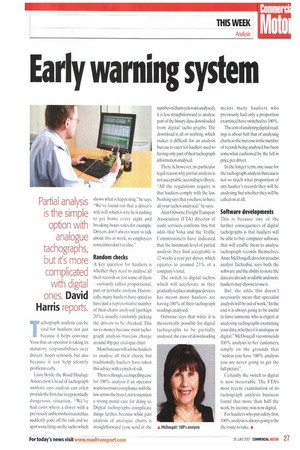Early warning system
Page 27

If you've noticed an error in this article please click here to report it so we can fix it.
Partial analysis is the simple option with analogue tachographs, but it's more complicated with digital
ones. David Harris reports.
Tachograph analysis can be vital for hauliers; not just because it helps convince Vosa that an operator is taking its statutory responsibilities over drivers' hours seriously, but also because it can help identify problems early.
Liam Boyle. the Road Haulage Association's head of tachograph analysis, says analysis can often provide the first clue to a potentially dangerous situation. "We've had cases where a driver with a previously unblemished record has suddenly gone off the rails and we spot something on the Lich° which shows what is happening," he says. "We've found out that a driver's wife is ill,which is why he is rushing to get home every night and breaking hours rules, for example. Drivers don't always want to talk about this at work, so employers sometimes don't realise."
Random checks
A key question for hauliers is whether they need to analyse all their records or just some of them — variously called proportional, part or periodic analysis. Historically, many hauliers have opted to have just a representative number of their charts analysed (perhaps 20%), usually randomly picking the drivers to he checked. This saves money because most tachograph analysis bureaus charge around 40p per analogue chart Most bureaus will advise hauliers to analyse all their charts, but traditionally hauliers have taken this advice with a pinch of salt.
There is, though, a compelling case for 100% analysis if an operator wants to ensure compliance with the law across the board, not to mention a strong moral case for doing so. Digital tachographs complicate things further, because while part analysis of analogue charts is straightforward (you send in the numberofcharts you wantanalysed), it is less straightforward to analyse part of the binary data downloaded from digital tacho-graphs. The download is all or nothing, which makes it difficult for an analysis bureau to cater for hauliers used to having only part of their tachograph information analysed.
There is, however, no particular legal reason why partial analysis is not acceptable,according to Boyle. "All the regulations require is that hauliers comply with the law. Nothing says that you have to have all your tachos analysed," he says.
Alan Osborne,FreightTransport Association (FTA) director of audit services, confirms this, but adds that Vosa and the Traffic Commissioners have indicated that the minimum level of partial analysis they find acceptable is 12 weeks a year per driver, which equates to around 23% of a company's total.
The switch to digital tac hos, which will accelerate as they gradually replace analogue devices, has meant more hauliers are having 100% of their tachograph readings analysed.
Osborne says that while it is theoretically possible for digital tachographs to be partially analysed, the ease of downloading means many hauliers who previously had only a proportion examined have switched to 100%.
The cost of analysingdigital readings is about half that of analysing eharts,so the increase in the number of records being analysed has been somewhat cushioned by the fall in price per driver.
In the longer term, one issue for the tachograph analysis bureaus is not so much what proportion of any haulier's records they will be analysing, but whether they will be called on at all.
Software developments This is because one of the further consequences of digital tachographs is that hauliers will be able to buy computer software that will enable them to analyse tachograph records themselves. Anne McDougall, director at tacho analyst Tachodisc, says both the software and the ability to store the data are already available and more hauliers may choose to use it.
But, she adds. this doesn't necessarily mean that specialist analysts will be out of work."In the end it is always going to be useful to have someone who is expert at analysing tachographs examining your data,whether it is analogue or digital." McDougall recommends 100% analysis to her customers, simply on the grounds that "unless you have 100% analysis you are never going to get the full picture".
Certainly the switch to digital is now inexorable. The FTA's most recent examination of its tachograph analysis business found that more than half the work, by income, was now digital.
For hauliers who put safety first, 100% analysis is always going to he the route to take. in






























































































































































































